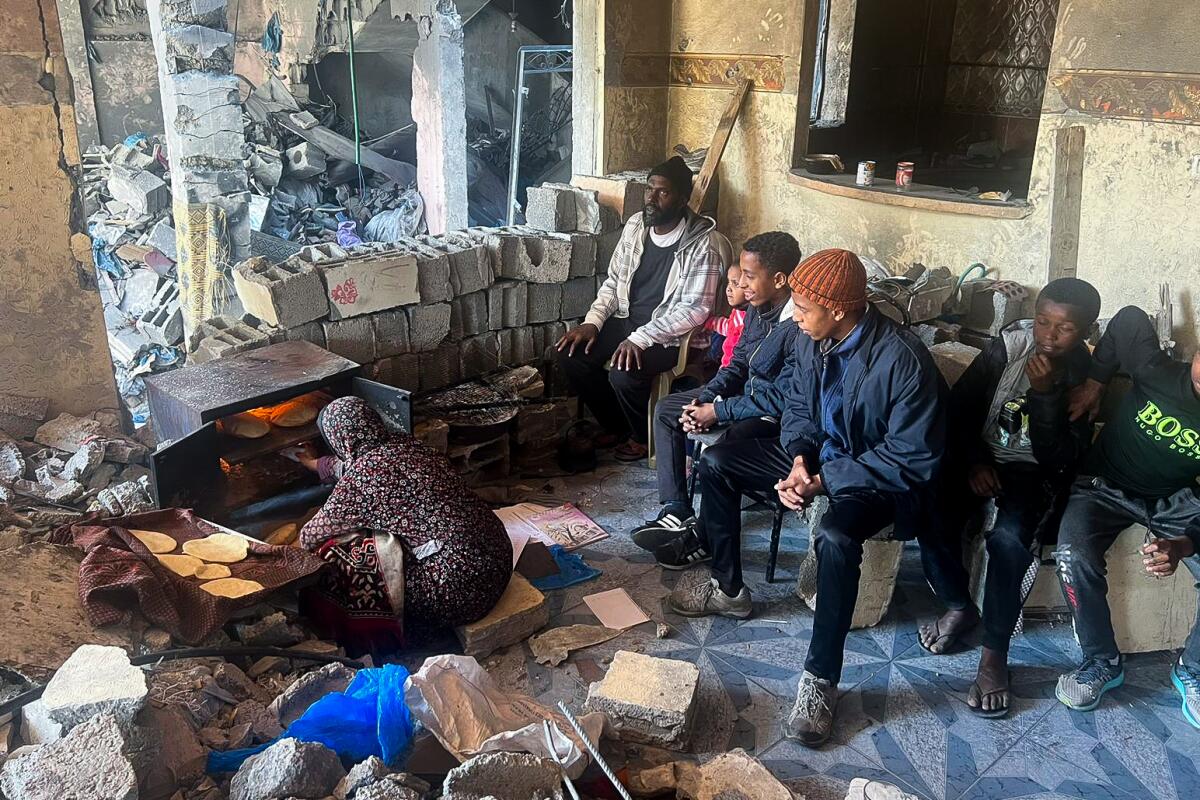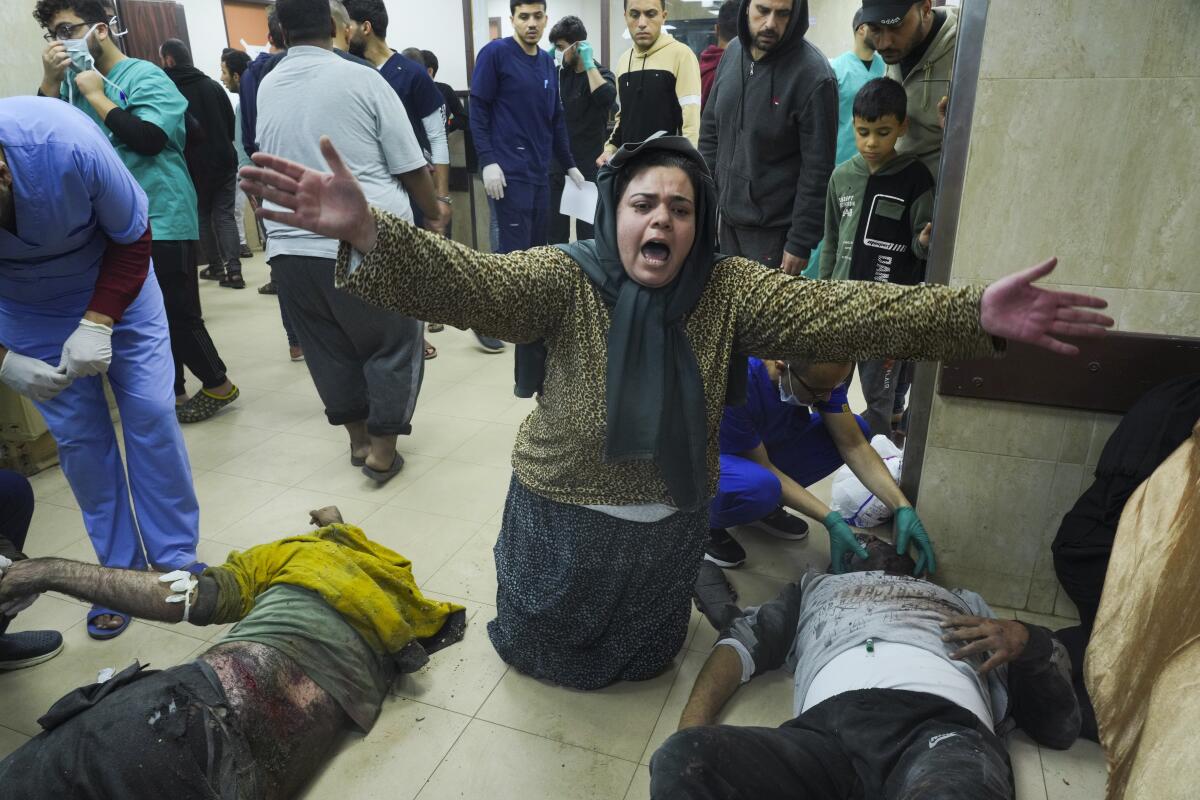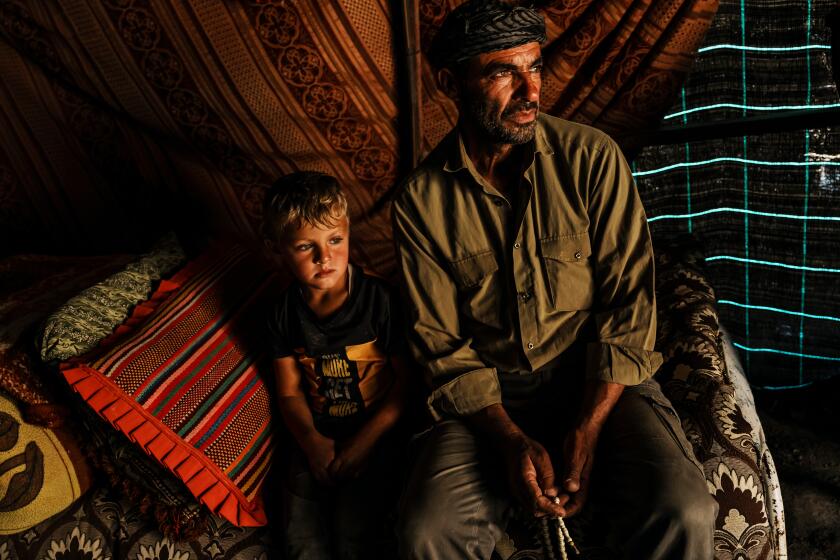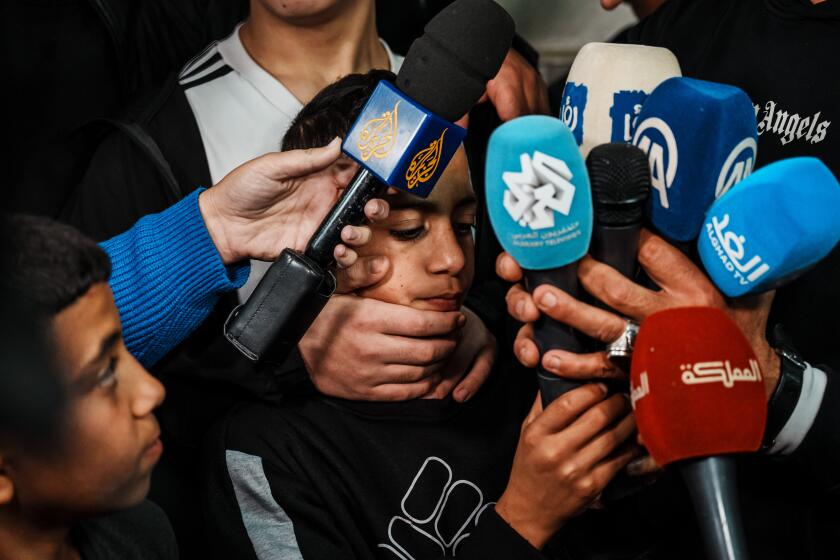In Gaza, she sits by her belongings, waiting for her home to be bombed

- Share via
DEIR AL BALAH, Gaza Strip — Umm Walid Hissi sat by a cart loaded with hastily packed belongings, waiting for her home to be bombed.
Until Sunday morning, she lived in Hamad Town, a collection of residential towers in southern Gaza’s Khan Yunis neighborhood. But on Saturday came the missiles, pounding down like a giant fist on one tower, then another, and another. A day later, word came to Hissi’s neighbors that their tower would be struck as well.
“They told us we had an hour,” Hissi said. “We honestly didn’t believe it, so we stayed. But then the police came and urged us to take the threat seriously.”
So she and more than two dozen family members fled, loading what they could in a donkey cart.
They managed to salvage mattresses, a few bags of flour, clothes. (Hissi was still angry about leaving behind the gas canister for cooking.) They wrangled their load to an area not too far from the towers to see whether the Israelis would carry out their threat, but were warned to move farther away.
They waited to see whether their home, like so many others hit in Israeli strikes, would be reduced to rubble. And they started to wonder where they would go next.
It’s a question being asked over and over in the Gaza Strip, with Israel ramping up its bombardment after the collapse of a temporary truce with Hamas, the militant group that rules Gaza. The fighting reached areas that had so far been relatively safe, as the Israeli military pursues what appears to be a new phase of a ground invasion in southern Gaza — where most of the territory’s 2.3 million residents had gathered after Israel ordered people to evacuate from the north.
The latest war in Gaza began Oct. 7, when Hamas operatives attacked communities in southern Israel, killing at least 1,200 people, mostly civilians, authorities say, and kidnapping some 240 others. Since then, Israel has responded with a blistering air campaign, blockade and ground war that have killed more than 15,000 Palestinians, local health officials say, the majority of them women and children.
This moment in the Israel-Hamas saga can be glimpsed in the fate of two fathers, strangers who share misfortunes brought on by larger powers and are now left to find their way
On Sunday, Gaza health authorities said more than 700 Palestinians had been killed in a 24-hour period, making it one of the war’s highest daily death tolls.

Khalil Degran, a doctor at the Aqsa Martyrs Hospital in Deir al Balah, in central Gaza, stood in the pediatrics department’s reception area and looked around. Every part of the hallway — every surface, every corner, even the reception desk — was claimed by the wounded and their families.
“We have no choice but to put them here. We just don’t have any space,” Degran said, glancing at a family that had staked out what was considered prime real estate in Gaza these days — a seating area with carpet and sofas.
As the Palestinian militant group Hamas frees more hostages amid a temporary truce with Israel, a harrowing glimpse of captivity in war-torn Gaza emerges.
Things had improved during the weeklong truce between Israel and Hamas, which ended Friday and had provided a desperately needed respite from the carnage of Israel’s military campaign in Gaza.
It had given the hospital staff a moment to breathe, a chance to empty out overcrowded hallways. But with the skies filled once again with missiles and bombs, the deluge of casualties had resumed.
“This isn’t a place for patients. How do you treat people here?” Degran asked, frustration edging into his voice. “What can we do?”
Like Hissi, Mohammad Sami, a 38-year-old accountant, also lived in the Hamad towers in Khan Yunis. But now he sits in a tent in Maghazi, a refugee camp in Deir al Balah that the Israeli military had designated as a safe zone.
A Times special correspondent in Gaza offers a personal account of living in a place where nowhere feels safe.
“We tried to rent in Rafah, but no one would take us,” he said, despite his willingness to pay 2,000 shekels, or $538 — twice the now-standard asking rate. He sent his wife and 5-year-old daughter to stay in a relative’s house in Rafah, and bought wood and and nylon strips to construct the tent for the men in the family.
Truce or no truce, warnings or no, Mustafa abu Breij, a 51-year-old day laborer in Gaza, made up his mind he was going nowhere, even though the home he’d built in the Maghazi camp was badly damaged in a bombing.
“There’s no place where we can live with our dignity other than home,” he said.
The strike, which happened before the truce, had targeted a neighbor’s home. Abu Breij was on the street when the missile struck, killing two of his nephews and knocking him unconscious.
Now the living room’s walls were in shreds, mostly gone, and his family — his wife, four boys and four girls — were squatting on the rubble-strewn floor, their chairs destroyed or used for their wood.
The recent hostage-for-prisoner swaps between Hamas and Israel have focused attention on the number of Palestinian minors imprisoned by Israel.
A Gaza resident who gave her name as Um Muhammad bakes bread on a wood stove in her family’s home, which was damaged in an Israeli bombing. (Special correspondent / Los Angeles Times)
Abu Breij’s wife, who gave her name as Umm Muhammad, 38, was baking bread on a wood stove. Getting cooking fuel was difficult during the truce; now, it was impossible. Umm Muhammad was using her bedroom furniture as kindling.
Building the house had been a grueling endeavor. Abu Breij had taken loans, saved as much as he could so his children “would have the kind of home I never had as a child,” he said.
“We didn’t even have a working bathroom when we first moved in,” he said, his voice modulating as he tried to stop himself from crying. When it was finally finished, “it was like a dream.”
Now, he said, “the dream is gone, buried.”
Though he wasn’t sure he would build again, he had come to accept, he said, “that walls and homes are no measure of a person’s existence.”
“Your determination and your will to live,” he said, “that’s all that matters.”
Near his old home in Hamad Town, Hissi waited with her relatives, watching the towers, waiting to see whether her home would survive or the Israeli military would destroy it.
“I think they will do it,” she said, exasperated. “I just don’t know where we’ll go.”
Times staff writer Bulos reported from Jerusalem and a Times special correspondent, who cannot be named for security reasons, reported from Deir al Balah.
More to Read
Sign up for Essential California
The most important California stories and recommendations in your inbox every morning.
You may occasionally receive promotional content from the Los Angeles Times.


















